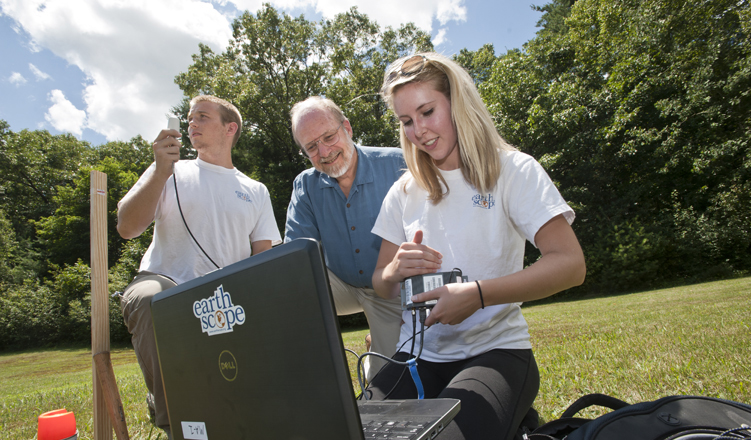
By
Earth and Environmental Sciences Professor John Ebel and rising junior Alissa Kotowski are leading an effort to find two dozen sites throughout New England to house seismic monitoring stations as part of the EarthScope Project, the most far-reaching seismic investigation of any continent in the world, deemed number one on a list of the "The Universe's Ten Most Epic Projects" by Popular Science magazine.
Kotowski is part of a two-person team criss-crossing the region asking landowners if they’d be willing to place a monitor the size of a large soup pot on their property as part of a government effort to blanket the nation with 400 seismometers capable of producing the most detailed profile ever of earthquakes and other seismic activity.
Property owners are being asked to provide space for 24 stations that will become part of the latest phase of the Transportable Array, a rotating nationwide web of measuring devices that relay data about seismic activity to a central computerized warehouse of information that is the basis of EarthScope, says Ebel, director of the University’s Weston Observatory.
The stations have been deployed throughout the United States for the better part of the past decade and for the next two years they will be monitoring the northeast, says Ebel, who adds that the project will produce a huge volume of data for analysis both during active monitoring and far into the future.
“For the two years the stations are in operation in New England, we get a bonanza of data,” says Ebel, who coordinates the project with Massachusetts State Geologist Steve Mabee. “The biggest difference is that with these stations in place, we will roughly triple the number of seismic stations we have operating in New England.”
Joining Kotowski in the field is Westfield State University student Malcolm Richardson. The team travels throughout New England and parts of eastern New York talking to landowners with properties best suited for the placement and operation of the solar-powered monitors and the transmission of data via cellular or satellite networks.
The project, funded by the National Science Foundation, supports integrated studies of the continental lithosphere and deep earth structure. As the earth transmits seismic waves, the transportable array and permanent measurement stations will provide the most detailed picture yet of activity taking place on the earth’s surface. It will also produce better, CAT scan-like images of the structure of the earth’s interior.
Ebel likened EarthScope and the Transportable Array to the milestone research initiatives of other fields, such as the Hubble telescope in astronomy or the Large Hadron Collider in particle physics.
“In the earth sciences, this is the biggest, most important project the U.S. government has ever funded,” says Ebel. “It’s tremendously exciting to be involved in this, particularly given its historic importance to the National Science Foundation.”



